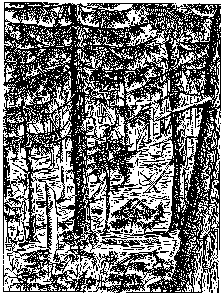Recommended Voluntary Forest Management Practices for New Hampshire
7.5 OLD-GROWTH FORESTS
BACKGROUND
New Hampshire’s old-growth forests are unique, valuable, and endangered natural resources requiring protection and conservation.
The forest that greeted New Hampshire's original European settlers exists today only as scattered remnants. Known as old growth, virgin, primeval, or ancient forests, they escaped harvesting or other human modification over the last 350 years. Carbonneau (1986) identified only 12 old-growth forest sites totaling about 3,000 acres—less than one-tenth percent of forest in the state. More old growth likely occurs as small patches at high elevations and on steep, less-accessible areas. Threats to old growth include timber harvests, acid rain, and invasive insects.
Old-growth forests exhibit ecosystem stability and little or no evidence of human disturbance. They have many or all of the following characteristics.
- Abundant old trees with long trunks free of lower branches, deeply furrowed or plated bark, signs of heartwood decay, large prominent root structures, flattened crowns with protruding dead limbs and large thick limbs, and trunks often showing a twist that develops with age.
- Abundant dead and downed logs in all stages of decomposition.
- Abundant moss and lichens on standing trees and downed logs.
- Abundant dead standing trees (i.e., snags).
- Large and small canopy gaps due to fallen trees.
- An undulating forest floor from pits and mounds where trees have fallen and decomposed.
- Multiple vegetation layers (e.g., canopy, understory trees, shrub, and ground cover) and diverse age classes.
- Undisturbed soils, and in some forest types, a relatively thick humus layer.
- A predominance of late-successional trees (i.e., shade-tolerant trees).
- A relative absence of multi-stemmed trees (i.e., coppices).
- No signs of human disturbance (e.g., cellar holes, stone walls, wire fence, roads, stumps).
Spruce, hemlock, yellow birch, beech, and sugar maple are the typical canopy species. Second growth or regenerating forests can also develop old-growth characteristics if sufficient time passes to obscure the effects of disturbance. In the northeast, at least 200 years is required to develop old-growth forest structure, although old-growth traits begin to develop at 100 years.
OBJECTIVE
Preserve and maintain the integrity of existing old-growth stands and allow the development of old-growth characteristics where possible.
CONSIDERATIONS
- Managing to retain or develop old-growth characteristics may entail a financial loss.
- Maintaining or restoring old-growth forest requires long-range planning and commitment.
- Establishing small patch reserves or extending harvest rotations helps develop old-growth characteristics in previously harvested stands.
- Forestry professionals, the N.H. Division of Forests and Lands and UNH Cooperative Extension can help landowners identify and manage old-growth forests.
RECOMMENDED PRACTICES
- Identify and locate old-growth and late-successional forests on managed lands.
- Include old-growth considerations in forest management plans.
- Protect and conserve old-growth stands and allow them to develop naturally.
- Consider restoring areas of old growth within managed forests by allowing stands to develop naturally. Candidate stands include late-successional stands with old-growth characteristics, stands on inaccessible or inoperable terrain, or within riparian management zones. Restored stands should be at least 5 to 10 acres to ensure old-growth structure and function.
- If permanent areas for old growth are desired but can't be established, manage for old-growth attributes by:
- Deferring cutting one to two rotations (about 80 to 160 years), or otherwise lengthening the rotation.
- Leaving large-diameter living and dead standing trees and large-diameter woody material on the ground.
- Using single tree or group selection.
CROSS REFERENCES
2.2 Forest Structure; 2.3 Regeneration Methods; 4.2 Wetlands; 4.3 Forest Management in Riparian Areas; 6.2 Cavity Trees, Dens and Snags; 6.3 Dead and Down Woody Material.
ADDITIONAL INFORMATION
Bennett, K. P. (tech. coordinator). 2005. Moving Toward Sustainable Forestry: Lessons from Old Growth Forests. Natural Resource Network Report. UNH Cooperative Extension, Durham, N.H. 82 p.
Carbonneau, L. 1986. Old-Growth Forest Stands in New Hampshire: A Preliminary Investigation. M.Sc. thesis, University of New Hampshire, Durham, N.H.
D’Amato, A., and P. Catanzaro. undated. Restoring Old-Growth Characteristics. UMass Extension, Amherst, Mass. 18 p.
D’Amato, A., and P. Catanzaro. undated. A Forest Manager's Guide to Restoring Late-Successional Forest Structure. UMass Extension, Amherst, Mass. 8 p.
Lapin, M. 2002. Old-Growth Forests: A Literature Review of the Characteristics of Eastern North American Forests. Vermont Natural Resources Council, Montpelier, Vt. 22 p.
Whitman, A., and J. M, Hagan. 2009. A Revised Rapid-Assessment Late-Successional Index for Common Northeastern Forest Types. Manomet Center for Conservation Studies, Brunswick, Maine.